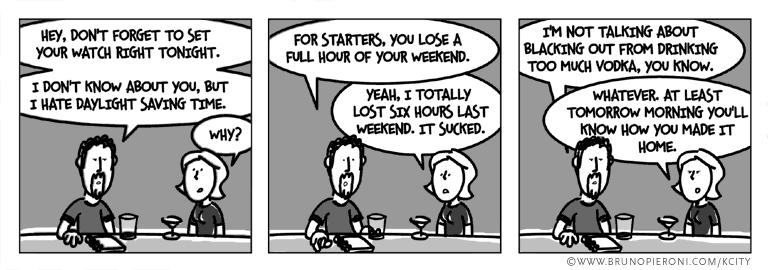
Posted on 11/02/2007 6:46:47 AM PDT by Lucky9teen
Daylight Saving Time is Here!
Fall Back on Sunday!

On Sunday, November 4 (the first Sunday in November) at 2 a.m., Daylight Saving Time ends in the United States. This year, Daylight Saving Time is four weeks longer than last year with the passage of the Energy Policy Act in 2005. The Act, which extends Daylight Saving Time by four weeks from the second Sunday of March to the first Sunday of November, is expected to save 10,000 barrels of oil each day through reduced use of power by businesses during daylight hours. (And ya'll thought Bush didn't care about saving oil....)
Every spring we move our clocks one hour ahead and "lose" an hour during the night and each fall we move our clocks back one hour and "gain" an extra hour. But Daylight Saving Time (and not Daylight Savings Time with an "s") wasn't just created to confuse our schedules.
The phrase "Spring forward, fall back" helps people remember how Daylight Saving Time affects their clocks. At 2 a.m. on the second Sunday in March, we set our clocks forward one hour ahead of standard time ("spring forward"). We "fall back" at 2 a.m. on the first Sunday in November by setting our clock back one hour and thus returning to standard time.
The change to Daylight Saving Time allows us to use less energy in lighting our homes by taking advantage of the longer and later daylight hours. During the six-and-a-half-month period of Daylight Saving Time, the names of time in each of the time zones in the U.S. change as well. Eastern Standard Time (EST) becomes Eastern Daylight Time, Central Standard Time (CST) becomes Central Daylight Time (CDT), Mountain Standard Time (MST) becomes Mountain Daylight Tome (MDT), Pacific Standard Time becomes Pacific Daylight Time (PDT), and so forth.
Daylight Saving Time was instituted in the United States during World War I in order to save energy for war production by taking advantage of the later hours of daylight between April and October. During World War II the federal government again required the states to observe the time change. Between the wars and after World War II, states and communities chose whether or not to observe Daylight Saving Time. In 1966, Congress passed the Uniform Time Act which standardized the length of Daylight Saving Time.
Arizona (except some Indian Reservations), Hawaii, Puerto Rico, the U.S. Virgin Islands, and American Samoa have chosen not to observe Daylight Saving Time. This choice does make sense for the areas closer to the equator because the days are more consistent in length throughout the year.
Other parts of the world observe Daylight Saving Time as well. While European nations have been taking advantage of the time change for decades, in 1996 the European Union (EU) standardized a EU-wide European Summer Time. This EU version of Daylight Saving Time runs from the last Sunday in March through the last Sunday in October.
In the southern hemisphere where summer comes in December, Daylight Saving Time is observed from October to March. Equatorial and tropical countries (lower latitudes) don't observe Daylight Saving Time since the daylight hours are similar during every season, so there's no advantage to moving clocks forward during the summer.
wow.. didnt think crickets would stop the thread in its tracks......
bahahahahahahaha!!!
Oh my, a mom after my own heart!
I love the holes in the wall
| You Are Midnight |
 Whether you're a nightowl, living in a commune, or taking a vow of silence - you like to experiment with your lifestyle. Expressing your individuality is important to you, and you often lie awake in bed thinking about the world and your place in it. You enjoy staying home, but that doesn't mean you're a hermit. You also appreciate quality time with family and close friends. |
We kept banishing our daughter to her room, but she wouldn’t stay.
So I turned the doorknob around.
Now the lock knob is on the outside.
I have 3 teenagers....
after breaking a few wooden spoons on their collective behinds, I have well behaved responsible kids
Who did get to go trick or treating
| You Are Happy Hour |
 You have a lot that drives you in life. The desire to be the best, and a secret hope of fame and power and Guinness. And while you definitely have a Type A personality, you are still fun to be around as long as you have enough Guinness. You have a ton of charisma and a genuine interest in |
| You Are Sunrise |
 You are a person of reflection and meditation. You start and end every day by looking inward. Caring and giving, you enjoy making people happy. You're often cooking for friends or buying them gifts. All in all, you know how to love life for what it is - not for how it should be. |
It’s amazing what threatening not to go trick-or-treating will do to get a kid to straighten up.
My boys were both pretty well behaved once I mentioned trick-or-treating, or not going if they didn’t behave. My 5 year old was a good Shrek and my 3 year old was a good little fireman.
This video has the highest number of views I've ever seen on You Tube; 2.4 million.

| You Are 56% Pure |
 But you also have a secret naughty side! |
My daughter was a kitty-cat. Our church had the parents and kids gather at the church, and while the moms took the kids around the neighborhood, the dads supervised the older youth as they gave out candy in front of the church.
Worked out great.

I was expecting the cat to do something. I didn’t see any fur flying.

| You Are Midnight |
 Whether you're a nightowl, living in a commune, or taking a vow of silence - you like to experiment with your lifestyle. Expressing your individuality is important to you, and you often lie awake in bed thinking about the world and your place in it. You enjoy staying home, but that doesn't mean you're a hermit. You also appreciate quality time with family and close friends. |
here is another good thread
Disclaimer: Opinions posted on Free Republic are those of the individual posters and do not necessarily represent the opinion of Free Republic or its management. All materials posted herein are protected by copyright law and the exemption for fair use of copyrighted works.